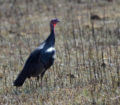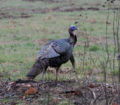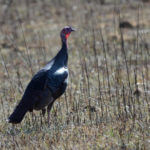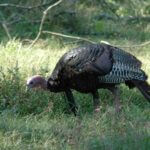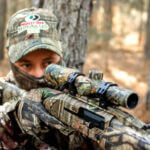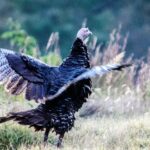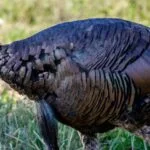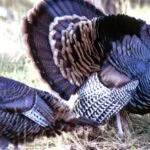John’s Note: As a youngster, J.R. Keller grew up in Delta, Colorado, and acquired a love for the outdoors from his father as he fished, hunted and camped with him. Through the years, Keller found a passion for turkey hunting that would consume most of his free time and lead him to become an avid turkey hunter and competition caller. This week we’re talking with J.R. about his turkey-hunting tactics.
1) Because you come from Big Sky Country where turkeys can see and hear for much-greater distances than turkeys in other sections of the country can, how do you determine how close or how far away you need to set-up from a turkey before you start calling to him?
Keller: In the West, a turkey can sound farther away from you than he actually is. Many, many times, I’ve had hunters from the East hear a turkey gobble and say, “Let’s go, we’ve got to get to that turkey.” What those hunters haven’t realized is that the turkey’s almost right on top of us. Instead of running to the gobbler, we need to sit down quickly and prepare to take the shot. You have to remember that in the wide-open spaces of the West, the sound of a turkey gobbling can be heard at much-greater distances than in areas with more dense foliage. Also, a gobbler can hear hen calls at greater distances in the West than he can in the East. So often I’ll start calling further away from the gobbler than hunters normally will. One rule of thumb to always remember is if you set-up too far away from the turkey and start calling, you can always move closer. However, if you get too close to the tom and spook him before you can call to him, your hunt is over. So if a turkey is gobbling, and you’re wondering whether or not to move closer before you start calling – don’t. Call from where you are, listen to how the bird responds to you, and determine if the turkey is coming to you, and if he’s not, then you can move closer to him.
 2) What do you do if you bump a turkey?
2) What do you do if you bump a turkey?
Keller: If I bump a turkey, I just sit down where I’ve spooked the gobbler and do nothing, maybe for 10 to 30 minutes. Then I’ll generally find another turkey to hunt. Often if one turkey is in a region, the bird’s there because that spot has plenty of food and water, which means usually more than one gobbler will be there. So, I don’t worry about the turkey I’ve spooked. I just start moving and trying to locate another turkey to hunt. If I can’t find another turkey to hunt, I’ll return to the place where I’ve spooked the turkey and start walking in the direction where the turkey either has run from or flown away from when I’ve spooked him. I may go 50 or 100 yards and blow my crow call to get the tom to shock gobble. If I can locate that turkey that I’ve spooked with the crow call, I may wait 5 or 10 minutes, figure out the direction and learn the direction that he’s walking.
Once I figure out the direction the turkey is walking, I’ll get in front of him, so that he’s walking toward me. If I’ll let about an hour pass from the time I’ve spooked him until the time I first try to make him shock gobble with a crow call, then I’ve got a very good chance to call in that turkey. When I’ve taken a stand in front of the gobbler, I’ll change calls. If I’ve been using a diaphragm call when I’ve called the turkey in and spooked him, then I’ll change to either a box call, a friction call like a slate or a glass call or a different type of diaphragm call. I’ll start calling very softly and see if I can get the gobbler to answer me. Often I can call in that spooked gobbler. The easiest thing to do after you spook a gobbler is to go and try to identify another turkey to hunt for at least an hour or two. But if you fail to locate another turkey to hunt, you can return to hunt the same gobbler you’ve spooked, if you’ll use these tactics. Like any other turkey technique, this strategy doesn’t always work. However, I have called in turkeys that I’ve spooked early in the morning by giving them a little time away from me and then hunting them again with a different type of call in a different place.
3) How do you hunt the turkey that gobbles and walks away from you?
Keller: If I’m hunting a turkey that’s gobbling and walking away from me, I assume that the gobbler has hens with him. You have two options when you’re hunting this type of bird. One, you can follow the turkey, continue to call every now and then, and keep up with his location. Sometimes, later in the morning, the hens traveling with that gobbler will leave him. Then the gobbler will turn around and start walking to your calling because the gobbler assumes you’re just a slow-walking hen that either won’t or can’t keep up with the flock. Since all his other girlfriends have left him, you’ve become the only date in town. He’s willing to put out a little extra effort and walk back and meet you. The second option is really the one I prefer. If I’ve scouted these turkeys and know the land, I’ll probably understand where this gobbler and his hens want to go and why they want to go there. All I have to do to take this turkey is get in front of him and his hens and reach the place he wants to go before he arrives there. Once I get to the spot where I plan to call the turkey, I’ll usually call very little and very infrequently. More than likely, this type of turkey will be found on public lands, and you know he’s already been called to by several hunters.
 You can make that assumption because:
You can make that assumption because:
* turkey hunters like to hear turkeys gobble, and the more a turkey gobbles, the more likely that most hunters will call to him.
* the more a turkey gobbles and walks away, the more hunters will chase him and call to him.
* the more a hunter chases and calls to a turkey that’s gobbling and walking away, the more other hunters on public lands will hear that turkey gobbling and start calling to him aggressively.
Because you’re hunting on public lands, you know that every hunter who hasn’t taken this turkey has more than likely called a lot and called aggressively. When I get out in front of this gobbler, I want to call very softly and infrequently. I don’t want to sound like a hen that’s trying to call the gobbler and the flock to her. Instead, I want to sound like a feeding hen that’s minding her own business and just happens to be out in front of the flock. I’ll give really-soft, subtle clucks and purrs. I want to be giving calls that are different from the calls that most other hunters have used to try and call this turkey.
4) How do you decide when to take the shot?
Keller: This question is one I’m often asked. Because the ammunition manufacturers are producing shells that extend the range of turkey shotguns and produce better patterns at greater distances, and too, because we have a larger number and a wider variety of better chokes for shotguns than ever before in the past, more hunters are attempting to take more turkeys at greater ranges than they ever have. However, I still believe that hunting turkeys and taking turkeys is a 30-yard game. I really don’t want to shoot at a turkey further than 30 yards from me. To me, the sport of turkey hunting is the hunter’s ability to call that bird to within 30 yards or less. I want to get a turkey as close to me as I can before I take the shot. Most of the turkeys I harvest will be at a distance of 30 yards or less. When I get a turkey to within 30 yards, I’m getting ready to take the shot. I’ll cluck at the bird and get him to stick his head up. Then I’ve got a much-longer target from the base of his neck all the way to the top of his head to take the shot.
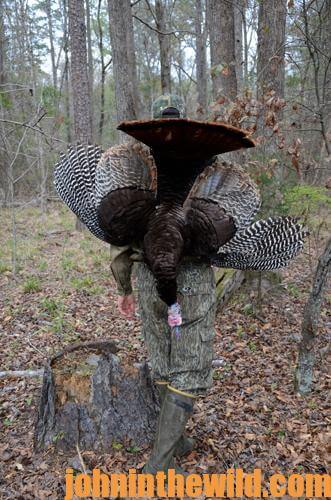 5) Do you use decoys, and do you think they are effective?
5) Do you use decoys, and do you think they are effective?
Keller: I believe the area that you’re hunting dictates how effective or non-effective decoys will be. For instance, if I’m hunting open terrain, I’ll often use a decoy because the decoy gives the gobbler something to focus on when he hears my calling. The turkey is already coming to you if he hears your calling. If he spots that decoy and thinks that it’s the hen that’s calling, then he has more confidence to continue to come toward the calling. I like to use decoys in the early season. However, I believe that later in the season as the gobblers become somewhat smarter, decoys aren’t as effective. If you’re hunting public lands late in the season, you have to assume that that turkey has probably seen several different types of decoys. So when I’m hunting in areas that have a lot of hunting pressure late in the season, I generally won’t use decoys. Late in the season, I’ll be calling really soft and subtle, and I want that gobbler to be coming in, looking for the hen that’s calling to him. For these reasons, I believe that the time of year you’re hunting, the type of property you’re hunting, and the amount of hunting pressure that property has had dictates whether or not to use a decoy.
To learn more about turkey hunting, check out John E. Phillips’ print, Audible, Kindle and Nook turkey books at https://johninthewild.com/books/#turkey and at www.barnesandnoble.com. You also can download a free Kindle app that enables you to read the book on your iPad, computer or SmartPhone. You can learn more about calling turkeys by going to johninthewild.com/audio-files/ for audio turkey tapes to purchase of Lovett Williams, Rob Keck and Chris Kirby, available for download to your SmartPhone, tablet or computer. For a free copy of John E. Phillips’ “The Turkey Gobbler Getter Manual,” go to https://johninthewild.com/free-books/ to download.

